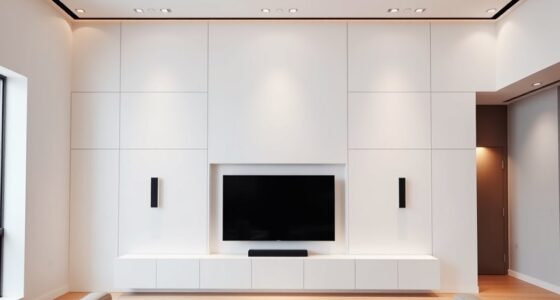Voice-controlled smart homes boost your accessibility and convenience by letting you manage devices hands-free, making daily tasks simpler. You can control lights, thermostats, and music effortlessly, which is especially helpful when multitasking or facing mobility challenges. Customizing responses and settings allows you to create a tailored experience that fits your lifestyle. To discover how to maximize these benefits while protecting your privacy, keep exploring more about these powerful, user-friendly systems.
Key Takeaways
- Voice control enables hands-free management of home devices, increasing accessibility for users with mobility challenges.
- It simplifies daily tasks like adjusting lighting, temperature, and music, enhancing overall convenience.
- Personalized voice profiles allow tailored interactions, making smart home experiences more accessible and user-friendly.
- Regular privacy settings adjustments help balance convenience with data security and user privacy.
- Voice-controlled systems support seamless, natural interactions, improving accessibility for users with physical limitations.

Voice-controlled smart homes are transforming the way you interact with your living space by enabling you to manage devices hands-free. Instead of fumbling for switches or trying to navigate complicated apps, you can simply speak commands to turn on lights, adjust the thermostat, or play your favorite music. This level of convenience makes everyday tasks smoother and more efficient, especially when your hands are full or you’re dealing with mobility challenges. However, as you embrace this technology, it’s important to consider privacy concerns. Voice assistants are constantly listening for their wake words, which raises questions about how your data is collected and stored. Manufacturers often implement privacy settings, but it’s up to you to stay informed and adjust these options to protect your personal information. You might also worry about accidental activations or unauthorized access, so understanding the privacy policies of your devices and regularly updating your software is vital.
User customization plays a significant role in making your voice-controlled smart home truly yours. Many systems allow you to personalize responses, set specific routines, and even create voice profiles for different household members. This means your smart home can adapt to your preferences, providing a more tailored experience. For example, you can program your voice assistant to recognize your voice and respond with personalized greetings or specific commands. You can also customize the way the system responds to certain questions or commands, making interactions feel more natural and intuitive. This level of user customization not only enhances convenience but also helps you feel more in control of your environment. You can choose which devices are voice-controlled and decide how they respond, creating a seamless integration that fits your lifestyle. Additionally, understanding the trustworthiness and vulnerabilities of AI systems can help you make informed decisions about which devices to incorporate into your home.
While the benefits are clear, it’s essential to strike a balance between convenience and privacy. Being aware of what data your smart home devices collect and how it’s used allows you to make informed decisions. You might opt to limit certain features or disable voice recording for sensitive commands. Additionally, regularly reviewing device settings and permissions ensures your smart home remains a secure space. Ultimately, voice-controlled smart homes empower you to customize your living environment for maximum comfort and accessibility, but they also require mindful management of your privacy. When used thoughtfully, this technology can elevate your everyday life, making your home smarter, more responsive, and better suited to your needs.
Frequently Asked Questions
How Secure Are Voice-Controlled Smart Home Devices From Hacking?
Voice-controlled smart home devices aren’t completely immune to hacking, but you can improve their security. They use encryption protocols to protect your data and device authentication to verify users. To stay safe, regularly update your device’s firmware, use strong, unique passwords, and enable two-factor authentication where available. These steps help minimize risks and keep your smart home more secure from potential threats.
Can Voice Assistants Understand Multiple Languages or Accents Simultaneously?
Yes, voice assistants can understand multiple languages or accents simultaneously. Imagine a household where family members speak different languages; the device uses multilingual recognition and accent adaptation to respond accurately. It processes various accents through advanced algorithms, allowing seamless communication. This feature makes smart homes more accessible and convenient, ensuring everyone’s voice commands are understood regardless of language or accent, enhancing overall user experience and inclusivity.
What Are the Privacy Implications of Using Voice-Controlled Technology at Home?
Using voice-controlled tech at home raises privacy concerns because your voice data could be stored or accessed without your knowledge. To protect yourself, enable user privacy settings and look for devices with voice data encryption. Be aware that conversations might be recorded or shared, so regularly review privacy policies and manage permissions. Staying informed helps make sure your voice data remains secure and your home stays private.
How Do Voice-Controlled Systems Handle Emergency Situations or Urgent Commands?
Imagine shouting “Help!” as smoke billows around you. Voice-controlled systems prioritize urgent commands through emergency protocols, quickly recognizing keywords like “fire” or “help.” They interrupt ongoing tasks to address your needs, alert emergency services if connected, and activate safety measures like opening doors or turning on alarms. This rapid response guarantees your safety, making voice systems essential during emergencies by prioritizing urgent commands above all else.
Are Voice Assistants Compatible With All Smart Home Brands and Devices?
Most voice assistants offer broad device compatibility, but they don’t work seamlessly with all smart home brands and devices. You should check brand integration and compatibility lists before investing. Popular assistants like Alexa, Google Assistant, and Siri support many devices, yet some brands or older products may require extra hubs or aren’t fully compatible. Confirming device compatibility guarantees your smart home functions smoothly and integrates well with your chosen voice assistant.
Conclusion
Imagine waking up to your smart home adjusting the blinds, brewing coffee, and playing your favorite morning playlist—all with a simple voice command. Voice-controlled smart homes make daily life more accessible and convenient, especially for those with mobility challenges. Just like Sarah, who now effortlessly manages her household despite her arthritis, you too can experience this seamless, hands-free comfort. Embrace voice technology and transform your living space into a smarter, more inclusive home.









